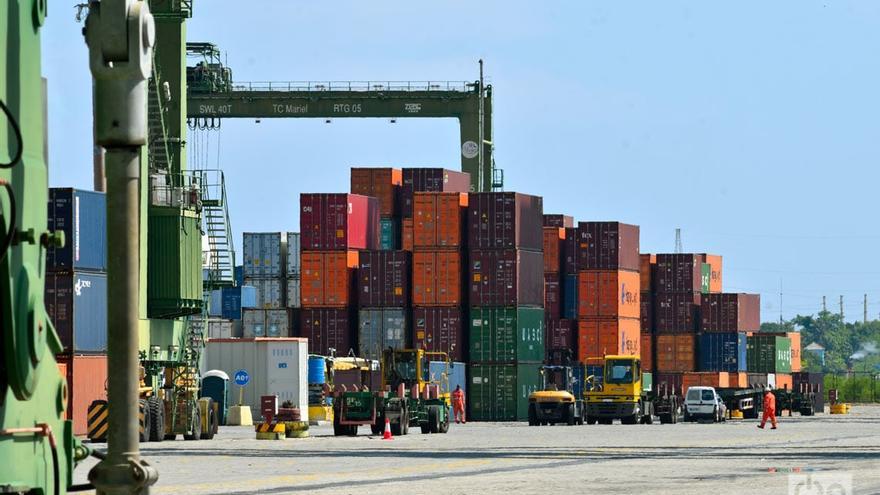
![]() 14ymedio, Havana, September 25, 2023 — Several months after finally completing the dredging of the access channel to the port, work that started more than ten years ago to allow the entry of larger vessels, the directors of the Mariel Special Development Zone (ZEDM) regret that not a single one of these vessels, up to 1,201 feet in length, has entered their container terminal.
14ymedio, Havana, September 25, 2023 — Several months after finally completing the dredging of the access channel to the port, work that started more than ten years ago to allow the entry of larger vessels, the directors of the Mariel Special Development Zone (ZEDM) regret that not a single one of these vessels, up to 1,201 feet in length, has entered their container terminal.
“The Mariel terminal (…) is still waiting for the arrival of its first Post Panamax ship,” says the OnCuba media, to which Mariel’s managers respond that they are in “negotiations” with several foreign shipping companies.
The eagerness of officials for the entry of ships such as the Post Panamax or the Neo Panamax – up to 1,201 feet in length, 171 in width and 49.2 in depth – lies in the concern that the port, in which millions in investments have been made, is not proving as profitable as expected.
The expansion of the canal allows large ships to make direct stopovers, which saves time and money in “transport costs”
In addition, says OnCuba, the expansion of the canal allows large ships to make direct stopovers, which saves time and money in “transport costs.” But the main interest of Havana is that the port of Mariel becomes the most important transfer point in the Caribbean, which would bring with it an injection of substantial capital for the country.
Martín José Spini, general director of the facility, insisted that the characteristics of the port, its geographical location, “security, certification and infrastructure,” make the Mariel terminal the ideal option for international shipping companies, and that if, so far, no large-haul ships have been received, he says, it is because of the “complex global economic scenario, resulting from the pandemic and the U.S. sanctions, which, among other difficulties, prevent ships arriving in Cuba from being able to touch U.S. ports in the next 180 days.”
Without being sure that it will have the success they expect, Mariel’s managers set the bar even higher. Currently, the terminal has a capacity of 800,000 20-foot containers, and an expansion is expected to allow up to three million containers to be received. However, the annual traffic does not exceed 300,000.
“By overcoming these obstacles and approaching what is foreseen in its Master Plan, the Mariel container terminal would be consolidated as one of the most important in the region, and a fundamental piece for the Cuban economy, severely affected by the crisis and in need of a commercial and financial injection,” emphasizes the newspaper, which adds that Mariel is the “main enclave for attracting foreign investment,” with more than 44 companies in operation, of the more than 60 approved since the foundation of the ZEDM in 2013.
With the creation of the ZEDM, a decade ago, the Cuban Government expected to receive about 12.5 billion dollars in foreign investments
With the creation of the ZEDM, a decade ago, the Cuban Government expected to receive about 12.5 billion dollars in foreign investments, at a rate of 2.5 billion per year. However, according to the figures offered by the state media, by 2023 the installation had barely reached 3.34 billion dollars of total investment.
However, both officials and the press are unaware of the multiple “difficulties” that the terminal has faced in recent years, which have little to do with the U.S. “blockade.”
At the beginning of September, the ZEDM announced that four years after its establishment in Cuba, the company Suchel TBV S.A – a joint company with the Vietnamese Thai Binh Detergent Joint-Stock Company – with an initial investment of 17.6 million dollars, was not yet in operation.
In 2020, the Russian state railway company RZD, which had agreed a year earlier with the Union of Railways of Cuba for the restoration of the Island’s railway structure, stopped operations due to recurring breaches on the Cuban side. The plans included the modernization of the train system that connects with the port of Mariel. Now, after a Chinese company took over the project abandoned by the Russians in 2022, the directors of the ZEDM promote the railway connection as a “reliable route” for the transfer of the merchandise that arrives at the port.
Officials, however, strive to sell the ZEDM as a “project that promotes, through foreign investments, technological innovation, industrial concentration and sustainable economic development, while ensuring the protection of the environment.”
However, on September 25, according to maritime tracking applications, the port of Mariel had only three boats in its docks: a container ship from Cyprus, a Panamanian oil tanker and the Baris Bey of the Turkish company Karpowership. This patana, (floating power generator), far from protecting the environment as assured by the ZEDM, emits toxic gases and presents a high risk of oil spills.
Translated by Regina Anavy
____________
COLLABORATE WITH OUR WORK: The 14ymedio team is committed to practicing serious journalism that reflects Cuba’s reality in all its depth. Thank you for joining us on this long journey. We invite you to continue supporting us by becoming a member of 14ymedio now. Together we can continue transforming journalism in Cuba.
